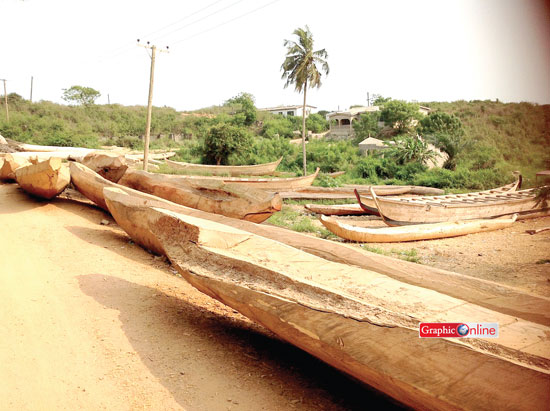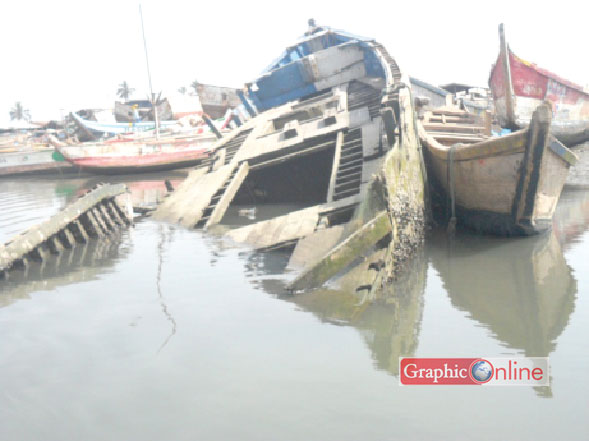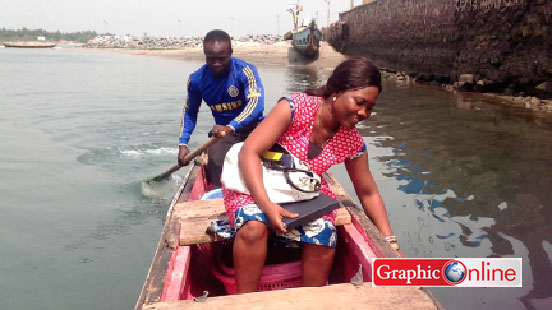Canoe making: A trade travelling centuries
The scene looked like a seaport without the sea or a canoe landing bay except that the sea was not close by. Shreds of the carved wood had combined with grass to give the “canoe shop” a “carpet”. Different canoes at different stages of construction. It’s a canoe-building site.
Advertisement
In Moree, a coastal community near Cape Coast in the Central Region of Ghana, three young men in their mid-20s were sawing wood, with their pencils in their hair, measuring, cutting, fixing and nailing. Eventually, after two weeks of hard, manual labour, they intend to finish work on an average sized-canoe for an eager client.
They had begun working on the canoe two days earlier. They are apprentice canoe builders and have over the years acquired enough skills and now need little supervision to work on a canoe.

The history of canoes dates back to time immemorial and their invention can be traced to the ancient people who settled near water (sea, stream, lagoon, river, estuary etc).
It was mainly used for fishing, transportation and war.
People from all walks of life have used canoes for one purpose or another. Jesus Christ is cited in Luke 5:1-11 as having sat in a canoe to preach.
Jonathan Swift also mentions canoe-making in his all-time classical book, ‘Gulliver’s Travels’.
“He contrives and finishes a canoe by the help of a fellow-servant, and put it to sea at a venture”, the book says.
From ancient days, the craft of canoe building has travelled over the waves of time and still feeds hundreds of mouths in our country.
Now Ayittey learns canoe making at Moree. He has worked as an apprentice canoe builder at the Moree canoe building bay for the past four years and says building a canoe is hard work. But he says so with a sense of pride.
Work on a canoe usually begins when a client, usually a fisherman, contracts masters of the trade for a canoe. Sometimes the customers provide their raw material, basically wood, for the work to be done. At other times, they contract the “masters” to find the raw materials and build the canoe at a cost.
Ayittey laughed about the fact that we were reporters and interested in what he does but agreed to talk.
“We have travelled to a lot of places to do this work. I have gone as far as Liberia to build canoes,” he told us.
They don’t charge clients; it’s their master craftsman who do that but they know exactly how much we need to get a canoe done.
Depending on the size, building a canoe would cost between GH¢700 and GH¢1,400 . This does not include the cost of wood. “You need much more if you don’t have the raw materials,” he said.
The wood, according to them, is obtained from the forest communities usually around Sefwi Wiaso in the Western Region.
After negotiations and a permit from the Forestry Commission, wood is cut and transported to the coastal communities where the canoes are usually built. “Not all carpenters build canoes. It is a specialised area and a common trade among young men in coastal communities. We cannot do much of other carpentry jobs. We are canoe builders,” Ayittey said with a grin.
Particles of saw dust filled the air as Ayittey paused and sawed the wood for the canoe.
Depending on the owner and the availability of materials, two weeks is an ideal time to finish one average-sized canoe.
The canoes are traditionally measured by one’s arm’s length.
Advertisement
“You stretch the two arms and tell the builder which size you want. It can be as long as 10 times two stretched arms,” he said
For Ayittey, canoe-building is a good job for young men. He said he could take care of a family with the income from building canoes when he graduates from his apprenticeship.

Our next point of contact was Elmina, where the Portuguese missionaries and colonisers first settled. Elmina is another fishing community, west of Cape Coast in the Central Region of Ghana.
Walking through the crowded fishmongers, the nauseating whiff from the fresh, dried and smoked fish almost made us sick and got to the fishing port of Elmina around 12:45p.m. and asked one of the fishmongers to direct us to where they made canoes.
Advertisement
The metallic bridge that links the Benya Lagoon to the Elmina Castle has deteriorated due to the sea breeze and age. We were justifiably afraid to walk on the bridge. You could see through the numerous holes in the metal plates on the bridge some of the fishing boats anchored under it.
Right after we crossed the bridge, we turned left as directed. From afar, we heard the sound of a chainsaw.
We followed the sound of the chainsaw. A few metres away, we saw a long canoe with some men at one end of it. A few canoes were assembled here, compared to Moree, where we first visited.
We asked to speak to the “master”. The gentlemen in their 20s called their “master.”
Advertisement
The elderly man put his chainsaw down and walked to us under the shade where they had packed their toolbox and food. The man was a little nervous, judging from his facial expression. “Akwaaba”, he welcomed us in Fante.
After exchanging pleasantries to calm him, 45-year-old Williams Martey, father of seven, narrated how he abandoned his job as a fisherman and got into canoe building.
Martey does not have formal education. He left school to join his father in fishing. Later as an adult, he joined others on fishing expeditions to make a living.
However, he said, he decided to quit fishing when he realised that those he went to sea with were cheating him.
“The fishing expeditions were also too risky for me. I realised I could die on any of the expeditions,” he added.
Martey said although his father wanted him to be a mechanic, he realised he loved canoe building more, especially with his experience as a fisherman.
The father of seven learnt the trade for five years from his master at Prampram in the Greater Accra Region, where he comes from and has been building robust canoes for fishermen for over 20 years now.
He said canoe building was one of the professions that required the use of uncommon knowledge as one must be extremely cautious at every step of the process since the least mistake could lead to loss of lives at sea.
Martey said it took about a week to construct an average-sized canoe with his two apprentices.
He stated that although he made a lot of money from building canoes, he believed he could manage his business more efficiently if he had some formal education.
“My deepest regret now is quitting school. Education would have helped me manage this business well. But it’s not too bad though. I take care of my children with the money I make from this business,” he said.
He indicated that canoe-making had taken him to Cote d’Ivoire and Togo and many fishing towns in Ghana, including Winneba, Apam, Axim, Half Assin, Tema and Accra.
Martey, however, stated emphatically that he had taught only three family members how to make the canoe and would not teach an outsider the craft.

Wawa wood is usually used for making canoes. A whole log is slashed into two or more depending on the sizes of canoes to be made. The hull of the canoe is usually carved out of a slashed log. This forms the base of the canoe and would determine the size of the canoe.
Small logs are bent with great artistry and skill, ensuring the wood is bent and not broken. The bent logs are then nailed one after the other on the hull, gradually giving the canoe the height it should have.
Mr Martey indicated that payment for the new canoe remained one of the problems for the builders.
Again, he noted that canoe-making required a lot of strength, “especially when you are doing everything manually.
“You can even die before your actual years God gave you on earth. You use a lot of energy when making the canoe,” Martey said.
But after strenuous efforts hitting crowbars, chiselling and hammering, a beautiful canoe is made.
Fishermen are the major patrons of these canoes.
How does it feel to journey in these locally made canoes?
We took a short trip on the Benya Lagoon in a small canoe.
Stepping into the canoe took courage. I stepped in first, almost slipping. Zadok followed. Kobina Mensah paddled us round answering all our questions. “You can call this one a taxi canoe,” he said. He paddled us onto the other side of the lagoon, towards the sea.
The wobbly ride was a bit uncomfortable initially but stabilised after some time.
The ride was another amusing exposure to the beautiful sight of an unending display of brightly painted canoes from the lagoon. You can’t miss the names of canoes which undoubtedly tell stories of beliefs, likes and aspirations of owners.




